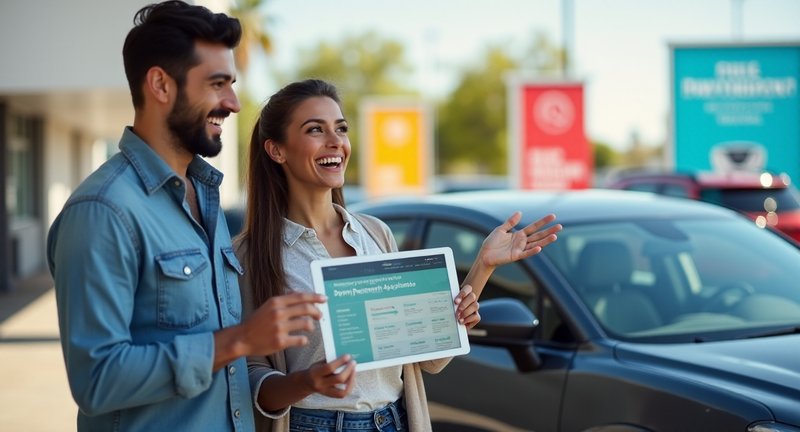Automobile Down Payment Assistance
Regarding buying a car, saving up for the down payment can sometimes feel like you’re climbing a mountain with no peak in sight. That’s where ” steps in, acting like a supportive hand, helping you get over that initial financial hump.
In my experience, not everyone realizes the different options available for this type of assistance. Here’s a quick breakdown of how it works and what you can expect:
-
Dealership programs: Some dealerships offer down payment assistance as part of their promotional packages. Keep an eye out for these deals, but always read the fine print. They can be a game changer, especially when you’re juggling other expenses.
-
Manufacturer incentives: Sometimes, automakers themselves offer programs to help with down payments. These incentives can be seasonal, so if you’re in no rush, waiting for the right time can save you a significant chunk of change.
-
Non-profit organizations: A lesser-known route, some community-based organizations offer assistance programs for individuals who meet specific criteria. These can be particularly helpful if you’re facing financial hardships.
Now, a word of caution from me. Not all forms of ” are created equal. Some may come with strings attached higher interest rates or hidden fees down the line. It’s always smart to sit down with a calculator and figure out whether the assistance is genuinely saving you money.

If you’re thinking, ‘Do I really need this?’ Well, imagine walking into the dealership with a stronger financial position because of that assistance. It takes a lot of the pressure off, allowing you to focus more on the vehicle you want rather than stressing over your upfront costs.
How Automobile Down Payment Assistance Works
Navigating the world of car financing can sometimes feel like trying to decipher a secret code. One of the most helpful tools in this maze is what’s often referred to as support for initial vehicle payments. This concept essentially helps ease the burden of that hefty upfront sum required when purchasing a new car.
From my own experience, I’ve found that this support can make a world of difference. It’s like having a friend offer you a hand when you’re carrying a heavy load. By reducing the amount you need to come up with initially, you’re more likely to drive away with the car you really want.
There are various programs designed to offer this kind of help. Some are aimed at first-time buyers, while others cater to those with specific financial situations. These programs can provide funds or other forms of aid to lower that initial financial hurdle.

Understanding how these programs work can save you from potential pitfalls. It’s essential to research thoroughly and find the option that best suits your financial landscape. Remember, every bit of assistance can be a stepping stone towards a smoother buying experience.
So, if you’re considering a new vehicle and dreading that initial cost, exploring these supportive options could be your ticket to a more manageable purchase. It’s worth taking the time to see how this financial aid could be your ally in getting the car you desire.
Understanding the Concept of Vehicle Purchase Assistance
Understanding the ins and outs of vehicle purchase assistance can be a bit of a puzzle, but once you break it down, it’s like finding a secret map to ease the financial burden of buying a car. Whether you’re a first-time buyer or upgrading your old ride, having a little help along the way can make a world of difference.
From my own experience, I’ve noticed that the most impactful vehicle purchase assistance comes in various forms. It’s not just about getting extra cash in your pocket; it’s about leveraging programs and resources smartly. Let me walk you through a few ways you might access this type of help:
-
Grants or Rebates: Some government agencies and non-profits offer incentives, particularly for eco-friendly vehicles. This isn’t money you borrow it’s more like a gift for choosing a cleaner option!
-
Special Financing Programs: Many dealerships offer partnerships with lenders who provide customized financing options. These programs often include lower interest rates or deferred payments that ease the pressure on your wallet.
-
Trade-in Credits: If you’ve got an older car, trade-in credits can significantly reduce your upfront costs. It’s like turning your used car into a bargaining chip.
-
Employee Discounts: If you work for a large company or in certain industries (like healthcare or military), many manufacturers extend exclusive discounts that can apply to your vehicle purchase.
The bottom line? Vehicle purchase assistance is a savvy way to lighten the financial load. Whether through rebates, trade-ins, or specialized financing, there’s more than one route to making your car-buying journey smoother and less stressful. It’s all about knowing where to look and which offers align with your needs.
Why Down Payments Matter for Car Financing
As for car financing, the down payment is your first real step into ownership. It’s not just about getting the keys; it’s about how you set the tone for the entire financing journey. I’ve seen time and time again how putting more money down at the start has ripple effects that many people don’t even consider.
A solid down payment can dramatically shrink the size of the loan, which means you’ll owe less in the long run. This is where it gets interesting less interest. Trust me, watching those interest charges stay low feels like a victory every single month.
From my own experience, skipping on a hefty down payment can lead to a financial snowball. Suddenly, you’re in deeper than you planned, and every payment feels tighter than the last. It’s amazing how a smart move upfront can give you breathing room later.
I’ve always looked at the down payment as an investment in peace of mind. You’re paying for control over your financial future. And let’s be honest, there’s something satisfying about knowing you’ve already chipped away at that balance before the first bill even arrives.
Think of it this way: with more skin in the game, the car doesn’t just sit in your driveway it feels like it’s truly yours.
Different Types of Financial Support for Car Buyers
With respect to purchasing a car, there’s more than one way to secure financial backing. From my experience, I’ve seen buyers explore a variety of options, and each one has its own unique perks. Let’s dive into some of the most common – and a few less conventional – forms of financial support available for car buyers.
-
Traditional Car Loans: This is the go-to for many, where a bank or credit union provides a lump sum, and you repay it over time with interest. While straightforward, rates and terms can vary wildly based on your credit score and financial history. Keep in mind, not all loans are created equal.
-
Leasing Options: If you’re not set on owning a car outright, leasing can be a smart way to enjoy a new ride without a huge upfront commitment. With lower monthly payments than traditional loans, leasing is perfect for those who prefer flexibility and switching vehicles every few years.
-
Manufacturer Incentives: From rebates to special financing deals, automakers love to sweeten the deal for buyers. Whether it’s a reduced interest rate or a cashback offer, these incentives can significantly reduce the total cost of your purchase. It’s like finding hidden treasure – you just have to know where to look.
-
Credit Union Financing: Often overlooked, credit unions can offer better interest rates than banks. These member-focused institutions tend to prioritize customer service and offer more personalized loan options. If you qualify for membership, this could be a golden opportunity.
-
Peer-to-Peer Lending: With the rise of online platforms, you can now borrow from individuals rather than institutions. The terms are often more flexible, and it can be a faster way to secure the cash you need, without the red tape of traditional banks.
Each of these options has its own set of advantages, and the best choice will depend on your unique financial situation.
Government Programs That Help with Car Down Payments
In relation to acquiring a vehicle, many of us find ourselves staring down the hefty initial payment. It’s a common stumbling block, but don’t despair there are some intriguing government initiatives designed to ease this burden.
In my own journey to a new car, I discovered that certain programs offer financial support specifically for the upfront cost. These initiatives can be a game-changer, offering a lifeline to those who might otherwise struggle with the initial expense.
For instance, veterans and low-income families often find themselves the beneficiaries of special programs aimed at reducing the financial strain of car ownership. These programs can come with various conditions, so it’s essential to dive into the details and see what fits your situation.
One of the most valuable aspects of these programs is the way they can ease the transition into car ownership. Imagine securing a vehicle without having to empty your savings or rely on high-interest loans sounds appealing, right?
If you’re considering this route, take the time to explore all available options. Each program has its own set of criteria, and understanding them thoroughly can make a world of difference.
Don’t overlook the potential benefits that these programs offer. They can be the key to unlocking new opportunities and making vehicle ownership more attainable. Keep an eye out for these helpful resources they might just be the solution you need.
Non-Profit Organizations Offering Auto Purchase Assistance
I’ve seen firsthand how transportation can be a significant barrier for individuals trying to improve their lives, particularly for those in underserved communities. Fortunately, there are non-profit organizations that step up to help people secure reliable vehicles, and it’s not just about cutting a check for the purchase. Many of these programs offer a holistic approach to transportation assistance.
Here are a few ways non-profits are making a difference:
-
Vehicle Donation Programs: Some non-profits accept donated vehicles, refurbish them, and give them to families or individuals in need. This not only solves the issue of access but also allows donors to contribute in a meaningful way.
-
Low-Interest Loans: Instead of turning to predatory lenders, individuals can apply for low-interest auto loans through organizations specifically focused on helping those with low or no credit. This gives people a chance to rebuild their credit score while securing a vehicle.
-
Transportation Voucher Programs: In some cases, organizations provide vouchers that can be used towards the purchase of a vehicle, offering a bit more flexibility to find something that suits the person’s needs.
-
Education and Financial Counseling: It’s not all about handing over a car; many non-profits combine vehicle assistance with financial education. This ensures recipients understand the total cost of vehicle ownership from insurance to maintenance.
Each of these approaches tackles the issue from a different angle, addressing not only the financial challenge but also the broader systemic barriers that keep people from accessing reliable transportation. It’s a relief to see that for many, the dream of owning a car doesn’t have to be out of reach.
Automobile Down Payment Assistance: A Complete Overview
Let’s dive right into Automobile Down Payment Assistance, shall we? It’s something that can make a significant difference when you’re eyeing that dream car but don’t want to drain your savings in one go. I’ve seen plenty of people benefit from these programs, and if you’re curious about how it works, you’re in the right place.
What exactly is Car purchase down payment support?
It’s a financial tool that helps you cover a portion of your down payment on a car. Instead of struggling to scrape together thousands upfront, this assistance takes the edge off, allowing you to get behind the wheel sooner.

From my experience, there are a couple of ways you might come across this kind of help:
-
Dealership Programs: Many dealerships offer special incentives, including down payment assistance to sweeten the deal. It’s worth asking when you’re negotiating.
-
Manufacturer Offers: Some carmakers run promotions that contribute to your down payment. I’ve seen these offers pop up more frequently during holidays or end-of-year clearances.
-
Third-Party Programs: Non-profits or financial institutions sometimes provide down payment assistance, especially if you’re a first-time buyer or meet specific income criteria.
Now, one thing I always recommend is to be cautious. Not all assistance is free money. Sometimes, it’s wrapped in the form of a loan you have to repay, so always read the fine print. But if done right, it can genuinely alleviate that initial financial burden.
If you’re looking at different ways to make car buying less painful on your wallet, exploring Vehicle down payment aid should definitely be on your list.
Auto Manufacturers and Dealer Incentives for Down Payments
I’ve seen firsthand how automakers and dealers can sweeten the deal for buyers when it comes to down payments. One of the most common strategies? Offering a bit of relief for that initial cash hurdle.
Sometimes, manufacturers will collaborate with dealerships to offer reduced upfront costs. This move allows buyers to drive off the lot without draining their savings. It’s a win for both parties buyers get into their cars with less stress, and dealers close the sale.
In other cases, I’ve noticed dealers throwing in matching contributions. Essentially, they’ll match a portion of what you put down. It’s almost like having a silent partner, helping you lower your loan amount from the start.
But it’s not always about direct cash contributions. Sometimes, incentives come in the form of special financing rates. I’ve seen promotions where buyers with strong credit get very low or even zero interest, making that smaller down payment stretch a lot further.
And don’t forget about seasonal or end-of-year promotions. From my experience, this is when the most generous offers show up. Dealers are looking to move inventory, and they’ll make the down payment as painless as possible.
If you’re in the market, it’s worth keeping an eye on these incentives. Timing and a bit of negotiation can mean the difference between a large financial strain and a manageable investment in your next vehicle.
Exploring Low-Income Assistance for Car Purchases
When I think about the challenges faced by low-income families in purchasing a vehicle, it’s like peering into a window of possibilities obscured by financial fog. Owning a car can open doors access to jobs, schools, and essential services but for many, the price tag feels like a mountain too steep to climb.
Many programs exist to help ease this burden, and it’s fascinating how they can transform lives. These initiatives often offer grants or interest-free loans, allowing folks to buy a reliable vehicle without the weight of crippling debt hanging over them.
One might imagine the thrill of driving off the lot, the engine humming with potential. Yet, securing funds for that initial leap is crucial. Some community organizations and non-profits focus on providing resources to help individuals navigate the maze of financing options.
Don’t overlook local government programs, either. They sometimes feature hidden gems, like rebates or matched savings accounts, designed specifically to support car buyers who need a little extra boost.
I remember hearing about a couple who turned their situation around by engaging with one such initiative. They not only secured a vehicle but also found a newfound sense of independence. Isn’t that what we all seek?
As you explore avenues for support, remember to gather information about eligibility criteria. Every bit of assistance can create ripples of change, making the dream of car ownership more attainable.
How Credit Unions Support Car Buyers with Down Payments
As for buying a car, many people don’t realize just how much credit unions can step in to help. Sure, getting financing is the first thing that pops into mind, but what about the initial hurdle the down payment? That’s where credit unions really shine, especially compared to traditional banks. Let me share a few reasons why.
First off, credit unions often offer more flexible terms when it comes to saving up for that down payment. Instead of setting rigid, one-size-fits-all rules, they look at your specific financial situation. Whether you need a little more time or creative savings solutions, they tend to work with you. Their goal isn’t to trap you in high payments; it’s to make sure you’re comfortable in the long run.
Here are some ways credit unions lend a hand:
-
Low-interest savings accounts: You can set up a dedicated car savings account with competitive interest, letting your money grow while you plan for the big purchase.
-
Special car-buying programs: Many credit unions partner with car dealers to offer down payment matching or reduced initial costs.
-
Tailored financial advice: You get one-on-one support to make the process smoother, including how to budget wisely for that initial deposit.
In my experience, credit unions also tend to have a community-first approach. They’re not there to just make a sale they’re focused on financial wellness. So, if you’re unsure about whether you can afford that dream car just yet, it’s worth having a conversation with them. They might surprise you with the ways they can help lighten the load of that upfront cost.
Trade-In Options and Reducing Your Down Payment
Let’s be honest, folks who doesn’t want to lower their out-of-pocket expense when buying a car? Trade-ins can be your golden ticket here. Think of it as a way to swap your current ride for a slice off the down payment. And hey, I’ve been through it myself; I know the drill.
First, understand your car’s worth. Don’t rely on a guesstimate from your neighbor’s cousin. Instead, get an appraisal from a few dealers or use online tools to see what your vehicle might fetch. You’ll want every dollar possible when it’s time to talk numbers.
Why trade-in can be a smart move:
- Instant equity: Your old car’s value can chip away at your new car’s price. It’s like finding money under your couch cushions but with more zeros.
- Lower loan amount: With a higher down payment from your trade-in, your financing needs shrink. That means you could negotiate for a shorter loan term or better interest rates.
- Sales tax benefit: In many places, the trade-in value is deducted from the price before calculating sales tax. It’s like a discount on your discount.
But, before you get too excited, let’s chat about a few caveats. If you still owe money on your current car, the trade-in value needs to cover the outstanding loan. Otherwise, you could end up rolling negative equity into your new loan, and that’s a spiral you don’t want to get into.
A tip from my own experience? Don’t get too attached to the number you see online. Dealers have their own metrics, and that online estimate might not match what you get offered. But with a little negotiation, you can walk away with a trade-in deal that slashes your down payment and keeps your wallet happy.
Leasing vs. Buying: How to Minimize Your Initial Costs
Concerning acquiring a vehicle, the eternal debate of leasing versus buying can feel like navigating a minefield. From my experience, the key to minimizing your initial costs lies in understanding the nuances of each option.
Leasing often appears as the more wallet-friendly choice upfront. With lower monthly payments and reduced cash outlay, it’s like slipping into a pair of comfortable shoes without the hefty price tag. You get to drive a shiny new car, enjoy the latest technology, and return it at the end of the lease term without the hassle of selling it later.
On the flip side, buying a vehicle is akin to planting a tree. While it requires a bigger investment from the get-go, the long-term benefits can bear fruit. You’re building equity, and once those payments are done, the car is yours to keep or sell as you please. Plus, there’s something satisfying about ownership that leasing just can’t replicate.
Now, if you’re leaning toward buying but feeling the pinch, there are clever strategies to cushion the blow. Think about seeking out special promotions or financing offers that reduce your upfront cost. Sometimes, local dealerships will have enticing deals that can take the edge off that initial investment.
Remember, the journey to vehicle ownership or leasing should reflect your financial landscape and lifestyle. Weigh your options carefully, and don’t hesitate to explore every nook and cranny of your choices. Your ideal ride is out there, waiting to roll into your life!
Down Payment Grants and Scholarships for Auto Buyers
When discussing purchasing a vehicle, many buyers find themselves wrestling with the upfront costs. Thankfully, there are some hidden gems in the form of grants and scholarships that can ease the financial burden.
I remember when I was navigating the daunting world of car purchases. Just as I thought I was stuck in a financial quicksand, I stumbled upon programs designed to help individuals like us. These opportunities are often tied to community development and aimed at boosting local economies.
Imagine receiving a grant that covers a portion of your down payment. It’s like finding an unexpected treasure! Not only does it lighten your financial load, but it also opens doors to a wider range of vehicle options.
Many organizations offer these grants, from non-profits to state programs. They typically have specific eligibility criteria, so it’s wise to do a little digging to see what’s available in your area.
I often advise friends to keep an eye out for scholarship opportunities, particularly those aimed at first-time buyers or individuals from underserved communities. You might be surprised by the resources available to you.
Also, taking advantage of these financial aids can significantly ease your journey toward vehicle ownership. So, don’t hesitate to explore every avenue; the right assistance could be just around the corner!
Using Personal Loans to Cover Car Down Payments
Let me tell you, covering a car down payment can sometimes feel like navigating a financial puzzle. One interesting option I’ve seen people consider is using personal loans to fill in the gaps.
Personal loans are flexible. Unlike car loans, which are tied to the vehicle itself, personal loans can be used however you like. Including, yes, that chunk of change you need upfront to drive away with your new car.
Now, before you get carried away, I want you to think about this carefully. You’re essentially borrowing money to borrow more money. It can work, but the trick lies in managing both loans responsibly. No one likes a payment shock at the end of the month.
In my own experience, it’s best to weigh the cost of the personal loan interest versus just saving up a bit more. Sometimes a little patience saves you from extra debt – but hey, I know the excitement of driving a new car can be hard to resist.
Keep in mind, this approach isn’t for everyone. You have to be in a good position with your credit score, and you should feel confident in handling both loans without stretching yourself thin. If that sounds like you, maybe a personal loan is your ticket to a faster ride.
Everything Explained
How do I get around a downpayment on a car?
To avoid a downpayment on a car, you can explore options such as negotiating with the dealer for a no-money-down deal, looking for special promotions, or applying for a loan that doesn’t require an upfront payment. Some lenders offer zero downpayment financing, but keep in mind that this often means higher monthly payments or interest rates. You can also trade in your current vehicle, using its value to cover or reduce the downpayment.
How can I get my car payment down?
To lower your car payment, consider extending the loan term to reduce the monthly amount, although this could lead to higher interest payments over time. Refinancing at a lower interest rate can also help. Additionally, offering a larger downpayment upfront reduces the total amount financed, leading to lower payments. If you’re struggling with payments, you can negotiate with the lender for a temporary reduction or seek out special loan programs.
How do I get around a down payment?
You can bypass a downpayment by seeking out financing programs that offer zero downpayment deals, or using a trade-in vehicle to offset the upfront costs. Some manufacturers or dealerships also run promotions where no downpayment is required. However, be aware that avoiding a downpayment may lead to higher monthly payments or more interest over the life of the loan, so it’s crucial to assess whether this is financially beneficial for you in the long term.
What can I use for a downpayment on a car?
A car downpayment can be made using various resources, including cash, savings, or the trade-in value of your current vehicle. Some people use a combination of these methods to make a larger downpayment. Additionally, you may be able to use money from a personal loan, though borrowing for a downpayment could increase your overall debt load. In some cases, certain lenders also accept other assets, such as stocks or bonds, as part of a downpayment.
What’s a good down payment on a 30k car?
A solid rule of thumb is to aim for a downpayment of 20% of the vehicle’s total cost. For a $30,000 car, this would amount to $6,000. A higher downpayment reduces the total loan amount, leading to lower monthly payments and possibly better interest rates. Additionally, putting down more upfront can decrease the risk of going ‘upside down’ on your loan, where the vehicle’s value is less than the amount owed on the loan.
Is $2000 a good down payment on a car?
A $2,000 downpayment on a car is reasonable, especially for a lower-cost vehicle. However, if you’re purchasing a more expensive car, such as one priced around $30,000, this amount represents just over 6% of the car’s value, which may result in higher monthly payments and a greater interest burden over time. Ideally, a downpayment closer to 20% of the car’s value would better manage costs, but $2,000 can still be a good start depending on your financial situation.
How to get a lower car payment without refinancing?
To lower your car payment without refinancing, consider extending the loan term, which can reduce the monthly amount, though it will increase interest over time. Making a larger downpayment upfront can also decrease your payments. Additionally, you can try negotiating with your lender for a temporary deferment or reduction in monthly payments if you’re facing financial hardship. Trading in your vehicle for a less expensive model is another way to lower monthly payments.
What is considered a high car payment?
A high car payment typically exceeds 15-20% of your monthly take-home income. If you’re spending more than this percentage on your car payment, it could stretch your budget, leaving less room for other financial obligations. The definition of ‘high’ also depends on factors like the loan amount, interest rate, and loan term, but if your car payment is affecting your ability to save or cover essential expenses, it’s likely considered too high for your income level.
What happens if I pay an extra $100 a month on my car loan?
Paying an extra $100 a month on your car loan can help reduce the principal balance faster, which may decrease the total interest paid over the life of the loan. It can also shorten the loan term, allowing you to pay off the car sooner. However, it’s important to ensure that your lender applies the extra payment toward the principal and not just future interest, so you see the full benefit of the additional payments.











Navigating car financing is definitely like a puzzle! I found support for initial vehicle payments to be a lifesaver when buying my first car. It made the process so much less stressful. I agree that it’s crucial to do your research; the right support can lead to a much smoother experience.
I absolutely resonate with the feeling of climbing a mountain when saving for a down payment! It’s amazing how much of a difference those dealership programs can make. I once snagged an incredible deal through a promotional offer that knocked a good chunk off my upfront costs. It’s essential to keep an eye out for those hidden gems, but as you mentioned, reading the fine print is a must. Understanding the different types of assistance available really empowers buyers. And trust me, walking into a dealership with that financial confidence is a game changer!